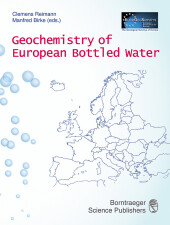 Neuerscheinungen 2010Stand: 2020-01-07 |
Schnellsuche
ISBN/Stichwort/Autor
|
Herderstraße 10
10625 Berlin
Tel.: 030 315 714 16
Fax 030 315 714 14
info@buchspektrum.de |

Manfred Birke, Clemens Reimann
(Beteiligte)
Geochemistry of European Bottled Water, w. CD-ROM
Ed. by Clemens Reimann and Manfred Birke
2010. XI, 268 p. w. figs. and tabs. 28 cm
Verlag/Jahr: BORNTRAEGER 2010
ISBN: 3-443-01067-9 (3443010679)
Neue ISBN: 978-3-443-01067-6 (9783443010676)
Preis und Lieferzeit: Bitte klicken
In Europe, ca. 1900 "mineral water" brands
are officially registered and bottled for drinking. Bottled waters is
groundwater and is in large parts of the continent rapidly developing into the
main supply of drinking water for the general population.
This book is the first state of the art overview of the chemistry of
groundwaters from 40 European countries from Portugal to Russia, measured on
1785 bottled water samples, equivalent to 1189 distinct bottled water brands
from 1247 wells in 884 locations plus an additional 500 tap water samples
acquired in 2008 by the network of EuroGeoSurveys experts all across Europe.
In contrast to previously available compilations, all chemical data (contained
on the enclosed CD) were measured in a single laboratory, under strict quality
control with high internal and external reproducibility, affording a single
high quality, internally consistent dataset. More than 70 parameters were
determined on every sample using state of the art analytical techniques with
ultra low detection limits (ICPMS, ICPOES, IC) at a single hydrochemical lab
facility. Because of the wide geographical distribution
of the water sources across 40 European countries, the bottled mineral,
drinking and tap waters characterized herein may be used for obtaining a first
estimate of "ground- water geochemistry" at the scale of the European
Continent, previously unavailable in this completeness, quality and coverage.
The data published here allow for the first time to present a comprehensive
internally consistent, overview of the natural distribution and variation of
the determined chemical elements and additional state parameters of groundwater
at the European scale. Most elements show a very wide
range, usually 3 to 4 but up to 7 orders of magnitude, of natural variation of their concentration. Data are interpreted in terms of their origin, considering hydrochemical parameters, such as the influence of soil, vegetation cover and mixing with deep waters, as well as other factors (bottling effects, leaching from bottles). A chapter is devoted to comparing the results from the bottled waters with those of European tap waters and previously published datasets. The authors also provide an overview of the legal framework, that any bottled water sold in the European Union must comply with. It provides a comprehensive compilation of current drinking water action levels in European countries, limiting values of the European Drinking/Mineral/Natural Mineral Water directives (1998/83/EC, 2003/40/EC, 2009/54/EC) and legislation in effect in 26 individual European Countries, and for comparison those of the FAO and in effect in the US (EPA, maximum contaminant levels [MCA]). The accompanying CD contains the extensive data sets, sample data (of 1189 different brands) and two previously published European water chemistry data sets.


